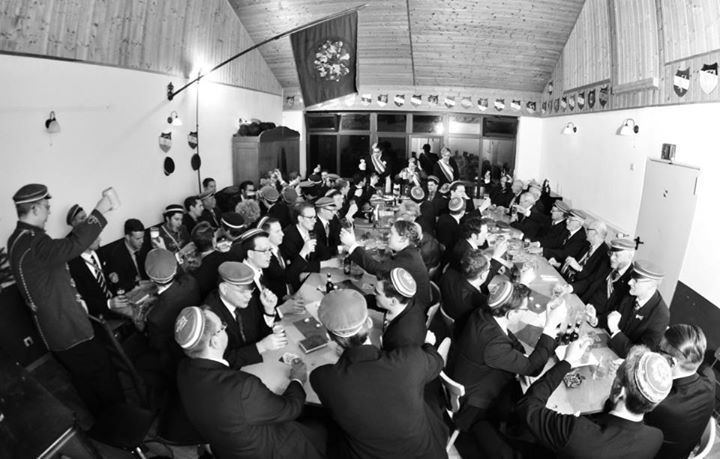 | ||
Beer fraternity and academic fencing
Corps (or Korps; "das ~" (n), [ˈkoːɐ] (sg.), [ˈkoːɐs] (pl.)) are the oldest still-existing kind of Studentenverbindung, Germany's traditional university corporations; their roots date back to the 15th century. The oldest corps still existing today was founded in 1789. Its members are referred to as corps students (Corpsstudenten). The corps belong to the tradition of student fraternities which wear couleur and practice academic fencing.
Contents
- Beer fraternity and academic fencing
- Characterization
- History
- Politics
- Sciences
- Economy and Engineering
- Fine Arts and Culture
- References
The corps are organized in two federations, the Kösener Senioren-Convents-Verband (KSCV) and the Weinheimer Senioren-Convent (WSC). Together, they comprise 162 Corps throughout Germany, Austria, Belgium, the Netherlands, Estonia, Latvia, Hungary, Switzerland and Lithuania.
The German Student Corps were traditionally recruited from the nobility, royalty and social elite, and are traditionally viewed as more aristocratic and elitist than other German student fraternities such as the Catholic Cartellverband and the Burschenschaften. They consider tolerance and individuality to be key tenets and are rooted in German idealism. By and large, they are generally conservative in political outlook, but less right-wing and less nationalist than the Burschenschaften. The corps are open to students of all nationalities and religions, unlike many other student fraternities. Although distinct, the corps are in some aspects similar to and serve many of the same purposes of college fraternities found in the United States.
Characterization
Corps are built upon the principle of tolerance: No corps may endorse a certain political, scientific or religious viewpoint. In addition, all members are solely chosen by their personal character. Neither national, ethnic or social provenance play a role.
Corpsstudenten (corps students) wear couleur (colored stripes and caps) and practice Mensuren, academic fencing with razor-sharp blades that can result in bleeding face wounds, Schmisse. The corps usually bear names that reflect their former origin from certain German regions, such as Saxonia (Saxony) or Guestphalia (Westphalia). Formerly, when a distance of a few hundred kilometres between a student's home town and his university meant weeks of travel, students from the same part of Germany traveled together and formed some kind of "new family". The distance, plus the fact that they carried the money for a complete semester with them in a bag, might also explain why students began fencing, simply for self-defense, for students, military officers and aristocrats were the only people allowed to carry arms.
Like all Studentenverbindungen, corps consist of two bodies: The active part consists of all members, that still study and have duties for the fraternity, and the so-called Altherrenschaft (alumni organization), comprising all those who graduated and thus provide the bear share of the monetary stimulus for the fraternity. A fundamental idea is that older students should help their younger fellows, and this principle dominates the relationship between the two bodies. The former keeps the everyday business of the corps alive, organizes gatherings, keeps the Corpshaus (Corps House) in order. The Altherrenschaft, graduates with regular incomes, provide financial support. This usually means quite cheap housing for the younger members among other things. The Altherrenschaft has the power to intervene in the business of the active members, typically to ensure the principles and spirit of their corps.
The active body is headed by a panel of three Chargierte (charged persons), who are elected by all active, full members at the beginning of each semester (or at the end of the former one). Their functions are called Senior, Consenior and Drittchargierter (meaning third charged person, also named Subsenior in some corps).:
Being the oldest of their kind, the corps tend to treat all other forms of German Studentenverbindungen with contempt; corps despise all posturing and affectation (e.g. the overly use of Latinisms) that other kinds of Studentenverbindungen, esp. Catholic corporations and Burschenschaften show. This does not mean that they consider other corporations as natural-born enemies. This might happen occasionally, but also vice versa.
Even with the principle of tolerance being a central aspect in each corps' self-image, every corps student is urged to develop his own viewpoints, to stand for them and to strongly participate in society, whether in politics, economy or social affairs. This encouragement for ethical and self-confident behaviour on one side, and the absence of a limitation to certain views on the other, let Corps students often show up as the leading figures of the most diverse political directions. The emphasis on individuality brought many corps students in opposition to totalitarian regimes, such as the National Socialist dictatorship.
The Weinheimer Student Corps also maintain a confederation with Tau Kappa Epsilon Fraternity, a college Fraternity with over 270 chapters in the United States and Canada.
History
The Corps sprang from the older Landsmannschaft. The name Corps came into use in 1810 at the University of Heidelberg and soon displaced the older name of Landsmannschaft at all the universities. The oldest still active Corps are the 1789 founded Guestphalia at the University of Halle, the 1798 founded Onoldia at the University of Erlangen who are both members of the KSCV and as a member of the WSC the Saxo-Montania founded also 1798 at the Bergakademie Freiberg today at the RWTH Aachen University. After the Carlsbad Decrees 1819 the Corps were exposed to harsh persecution by university and state officials just like their rivals as at the universities in Germany the Burschenschaften. After 1848, they were officially approved.
